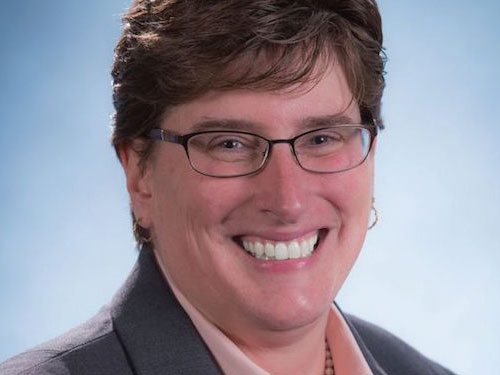New Port Commerce Director Bethann Rooney tackles infrastructure, and environmental priorities.
When President Joe Biden and his administration began to confront the ocean transportation supply-chain problems brought on by the COVID-19 pandemic, their central message to ports was that all stakeholders needed to talk to one another if the situation were to improve.

The council was the brain-child of Bethann Rooney, who in May took the reins of the port commerce department as director, capping a decades-long career at the Port Authority. Rooney started at the Port Authority in 1993, when she worked in marine terminal operations, before heading to property management and leasing. Later, she worked on intermodal transportation solutions, including the development of the ExpressRail system and the cross-harbor barge service, then became the PA’s point person on technology and efficiency. After the terror attacks of September 11, 2001, Rooney was appointed the Port Authority’s head of security, remaining in that position for 14 years until she was appointed the assistant port commerce director, where she concentrated on supply-chain optimization, environmental initiatives, policy, and legislation. As port commerce director, these and much more are now on Rooney’s plate.
Council on Port Performance
Right before the pandemic started, ironically, the Council on Port Performance made the decision to scale back the frequency of its meetings, a decision which it quickly reversed. “When our region became the epicenter of the pandemic, we made a decision to meet on a weekly basis,” said Rooney, “to provide status reports and to understand where the pain points were.”
An early concern was that, as the world shut down, ships would still be calling at the port, causing a backup of cargo in the terminals. “If there wasn’t enough warehouse space, we would then have ships backing up into the anchorage,” said Rooney. “So, the council identified every square inch of space that was available at the time in warehouses and empty storage yards.” That turned out to be over 90 parcels, which were made available to cargo owners who needed the space.
In 2021, the port experienced an unusual 18.5% increase in cargo volumes, over seven times its growth rate in recent years. “We did not have more than three or four ships at anchor at a time and they weren’t staying there for more than a day or a day and a half,” said Rooney. “We were pretty fluid, and I directly attribute that to the coordination, collaboration, communication, and transparency facilitated by the council.” Wait times at the port have since deteriorated, and a glut of empty containers has accumulated, requiring measures that go beyond the council’s purview.
“Unfortunately, the council doesn’t have the authority to force port entities to do anything,” Rooney added. “But there is value in having all of the sectors of the supply chain represented in discussions and there is also some peer pressure involved.”
This year saw little change in cargo trends at the port, although some of the cargo characterized by pandemic buying has decreased. “The volume of furniture is down quite a bit this year,” said Rooney. “The folks who moved out of the city have already outfitted their homes, offices, and gyms.”
Automobile volumes at the port have been challenged because microchip scarcities have compromised manufacturing processes. Also, many auto parts are now coming into the port as breakbulk cargo rather than in containers. “It’s because of the supply-chain challenges on the container front,” Rooney explained. “Parts are now being shipped in crates on ro/ro vessels, then trucked to auto production facilities in the Midwest.”
Port Infrastructure Moving Along
When it comes to infrastructure developments at the port, “Everything’s moving along,” said Rooney.
A significant recent development was the release of an engineering report on deepening the shipping channel to 55 feet. Rooney expects that project to be authorized by Congress when it next takes up maritime infrastructure and that the engineering design phase for the channel deepening will begin in 2023.
“We also have a major wharf and berth replacement program,” said Rooney. “Most of our berths are between 50 and 80 years old, so we’ll be looking to systematically replace each of them to increase their load-bearing capacities.”
The Port Authority received a $44 million federal grant to improve the street configuration and entrance road on the north end of Port Newark. “We’re in the final stages of an environmental assessment for that project,” said Rooney. “We hope to put the document for that project out on the street before the end of this year and to award a contract and be in construction before the end of next year.”
A major intermodal project is in the works in the form of a Southbound Connector, which is about to enter its final design stage. “Virtually all of the trains out of ExpressRail facilities need to head north,” said Rooney. “The Southbound Connector would allow trains out of ExpressRail Elizabeth, which services both the Maher and APM terminals, to go to the south and avoid the choke points around areas where trains are being built. That is going to provide additional redundancy and resiliency.” The Port Authority is currently working on a grant application that it hopes will fund some of the projects.
On the environmental front, the Port Authority has studies and analysis underway on upgrades that need to be made to support electrification. “Trucks will be transitioning away from diesel,” said Rooney, “and we need to understand what type of electrical infrastructure we need. We expect that the studies underway now will help to close the gap between where we are versus where we need to be to support decarbonization efforts.”






